From humble beginnings in a Japanese music school, Suzuki teaching has become one of the most popular forms of music education worldwide. In this feature from September 2012, Laurie Niles reports on the programme’s global impact

In the 1950s, string teachers in the West, began to catch wind of a Japanese man named Shinichi Suzuki, who was teaching remarkably young children to play the violin. A film circulated of 750 Suzuki students – tiny children – playing the Bach ‘Double’. It was a feat not thought possible at the time and teachers were astounded. The great cellist Pablo Casals travelled to Tokyo to see a group of these children perform, after which he made his famous pronouncement: ‘Perhaps it is music that will save the world.’ After living through nearly the entire 20th century, Shinichi Suzuki died in 1998 at the age of 99.
Since then, his philosophy and method of music education have continued to spread across the world, affecting the musical education of hundreds of thousands of children. Reactions among educators have ranged from rapturous embrace to outright disdain.
Where does the Suzuki method stand now, nearly 15 years after his death? ‘It used to be thought that music was for the talented, and what separates the Suzuki method from a lot of the traditional approaches is Suzuki’s philosophy that every child can learn,’ says Brian Lewis, violin professor at the University of Texas, who counts both Suzuki and Dorothy DeLay among his teachers. His mother, Alice Joy Lewis, was a pioneer in bringing the Suzuki method to the US. This empowering idea has propelled the method not just across America but throughout the world. Programmes now exist on almost every continent.
Since 1983 the International Suzuki Association (ISA) has helped coordinate the Suzuki method around the world, for the purpose of consistency, and to maintain standards and promotion. Additionally, fi ve regional Suzuki associations have been licensed by the ISA: the Asia Suzuki Association (ASA), European Suzuki Association (ESA), Pan-Pacifi c Suzuki Association (PPSA), the Suzuki Association of the Americas (SAA) and the Talent Education Research Institute of Japan (TERIJ). ‘It is growing particularly rapidly in places like Estonia, Latvia, Lithuania, Croatia and Turkey,’ says London-based Suzuki pedagogue Helen Brunner.
Europe was slower than the US to adopt Suzuki methods, she recalls: ‘America took to Suzuki in a way that was quite unusual, and it didn’t happen in Europe that way at all. We had to fight every single step of the way.’ Now, however, it is possible to hold large-scale events in Europe, such as the concert at London’s Royal Festival Hall last March involving 1,200 young Suzuki students. A similar event in Paris in April featured 1,000 children playing.
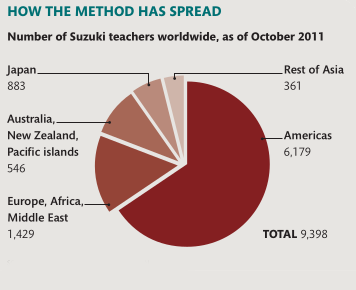
WHAT IS SUZUKI?
The Suzuki method grew from the educational philosophy of Shin’ichi Suzuki, born in Nagoya, Japan, in 1898. His struggle to learn German gave him the idea that sparked his philosophy of teaching: that every child fi nds it easy to learn their native language. Suzuki’s ‘mother tongue’ approach to teaching music builds on the principles of language acquisition. The method started as a way to teach children to play the violin, but now encompasses viola, cello, piano, bass, flute, recorder, guitar, harp, voice, organ, mandolin and early childhood education. Suzuki’s seminal book of education philosophy is called Nurtured by Love. Here are some aspects of the Suzuki method:
Early start
Children’s brains are most open to learning new mental and physical processes when they are very young. They start learning language from day one; likewise with music. In the Suzuki method, children can start learning to play instruments from the age of two or three.
Environment
Children learn to speak while immersed in an environment of language, so the Suzuki method aims to provide an immersive musical environment. Thus, Suzuki students are required to listen regularly to recordings of the pieces they are playing.
Parental involvement
A parent attends the child’s lessons and is treated as ‘the home teacher’. Parents are expected to help their children practise at home, modelling good technique as they would model correct language. As students grow older, the parents’ involvement decreases.
Repetition
Students are never finished with a piece, but keep playing and reviewing repertoire as they learn new techniques. In this way, they can build up their ‘vocabulary’ of technique.
Group lessons
Children practise their language skills by talking with friends of their own age. Similarly, they can develop their musical talent by playing with other young people who are practising the same music. Group lessons build motivation and community spirit, as children make new friends and witness other pupils’ accomplishments. Students take both private lessons and group lessons.
Whole person
‘Teaching music is not my main purpose,’ Suzuki said. ‘I want to make good citizens — noble human beings. If a child hears fine music from the day of his birth, and learns to play it himself, he develops sensitivity, discipline and endurance.’
‘The Suzuki method is widely known and respected, especially in Britain and the Nordic countries,’ notes ESA chairman Martin Rüttimann. ‘For a while, in the countries where they already had a tradition of music education for children – such as France, Spain and Austria – it was more diffi cult. On the other hand, we have Poland, also with a very old tradition in music education, where the introduction of the Suzuki method was a big hit. They started about ten years ago and already have nearly a hundred teachers.’
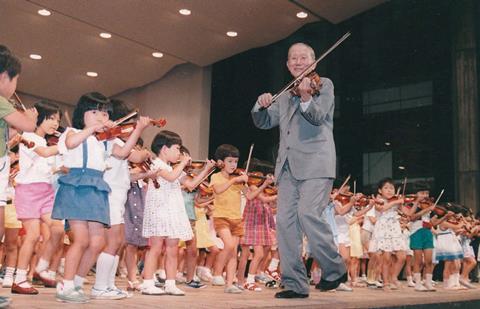
’The strongest programmes in Asia are those that have been established for the longest period of time: South Korea and the Philippines,’ according to ASA member Therese Wirakesuma. ‘The Suzuki method is well respected and understood in South Korea as a method for small children to reach a high level of achievement in learning classical music,’ she continues.
‘Koreans love to study music, and it’s rare that a child in the middle or upper class doesn’t learn an instrument. They have high expectations and it’s not unusual for very young children to be practising for well over an hour daily and playing Book 4 and above by the time they are six or seven years old.’
‘America took to Suzuki in a way that was quite unusual’
HELEN BRUNNER
The Philippine Suzuki Association was established in 1992 by piano pedagogue Carmencita Arambulo, with support from Shinichi Suzuki’s student, Yasuki Nakamura. ‘Many Philippine Suzuki students have won national competitions, and others have received scholarships for studies abroad,’ Wirakesuma says.
‘Quite a number of members of the Manila Symphony Orchestra received their training in the Suzuki method before they became professional musicians.’ She also acknowledges, however, that ‘economic diffi culties, natural disasters and the migration of trained teachers often take their toll’, slowing Suzuki’s growth.
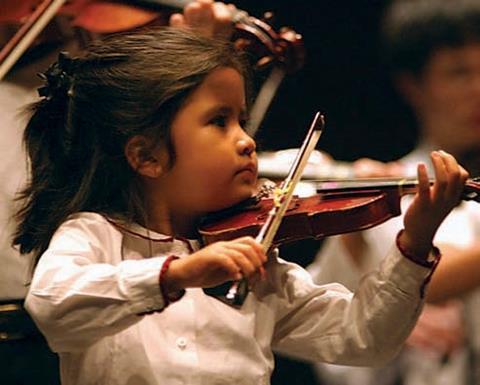
In Malaysia and Indonesia, Wirakesuma says, the Suzuki method was only established in the past few years. ‘In these countries, Suzuki books can be seen in music schools and are used in teaching lessons, though the training of tutors and the teaching of children using the method has only begun recently.’ In 2009 Wirakesuma herself founded the Indonesian Suzuki programme, which currently has 400 students and 50 teachers spread across the archipelago.
The Malaysian Association was founded in 2008. The PPSA includes chapters in New Zealand and in the Australian states of Victoria, New South Wales, Queensland, South Australia and Western Australia. The capital cities have the greatest number of participants, according to Suzuki flute teachertrainer Julia Breen.
Suzuki has been taught in these areas since the 1970s and one change that has made things easier, she believes, is the increased availability of small-sized instruments. Much of Japan’s Suzuki activity is centred on Matsumoto, the city where Shinichi Suzuki lived and the venue for the 16th Suzuki Method World Convention in March 2013. ‘Suzuki’s death was such a big loss, beyond description,’ says Fumiyo Kuramochi of the TERIJ.
‘However, he entrusted the teaching of the Suzuki method to Koji Toyoda, who grew up in his family. Koji has led Japanese Suzuki teaching for more than ten years, and continued to communicate the philosophy of Suzuki’s method.’ Studios in Japan work slightly differently from those in the West, as US Suzuki teacher Julie Bamberger has discovered from her regular visits to Japan over the past 20 years: ‘Families overlap – there’s a constant stream in and out, and at least two or three students there during a lesson.’Group classes can be as long as two hours, with parents and students remaining attentive throughout.
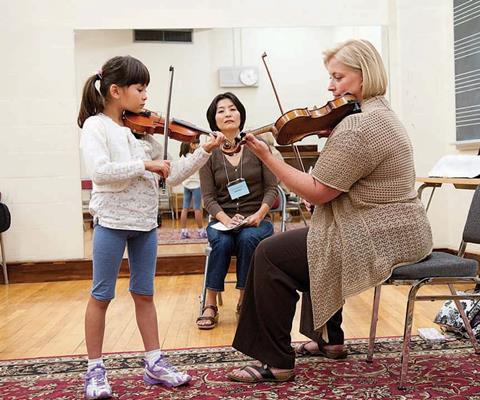
Shinichi Suzuki trained in Germany with Karl Klingler, a string quartet player who was a student of Joseph Joachim. Suzuki’s European training is refl ected in his use of the Franco–Belgian bow hold, his predilection for German folk songs and his ultimate goals for students, which go far beyond the repertoire in his books. ‘There are ten volumes for violin, but there’s another list of repertoire he made beyond that,’ Lewis points out. That list includes advanced repertoire like the Vitali Chaconne, Kreisler’s Praeludium and Allegro and the concertos by Bruch, Mendelssohn and Tchaikovsky. Suzuki certainly meant to set students up for advanced study. The method has also proved adaptable to various cultures. Suzuki believed in starting out with folk songs, because they are familiar to children and singable.
The Suzuki books contain German folk tunes, but many Suzuki groups also use the folk music of their own cultures. ‘Suzuki pupils and teachers in Europe have always connected with the traditions of music in their countries,’ comments Haukur Hannesson, a Suzuki cello teacher-trainer based in Sweden. ‘In Ireland or Sweden, for example, they have a huge tradition of folk music, and this is informally incorporated into their respective Suzuki programmes.’ Likewise in America: ‘We’ve been playing fi ddle songs and American music since I was a child in the 70s,’ says Brian Lewis. Nicolette Solomon, currently the director of the Suzuki Music Institute of Dallas, pioneered the first Suzuki programme in South Africa. Suzuki outreach programmes there are now reaching into the black townships. ‘They don’t all have access to CD players,’ explains Solomon, ‘so they are using a lot of Suzuki principles and materials and transplanting them to the folk tunes that African children sing. It’s completely Suzuki for Africa.’
Suzuki had high expectations for teachers: he required the people he trained to take an oath to continue their own education and growth as teachers and musicians. To this end, Suzuki teachers have a culture of sharing their teaching ideas, and hold workshops, seminars and conferences for the sake of continuing their education. In May of this year, 900 Suzuki teachers met in Minneapolis for the biennial SAA Conference, with 150 sessions on the programme. These included pedagogy classes on solo Bach and other topics; lectures on supplementary materials to the Suzuki books; performances by high-level students; masterclasses; and ideas for group classes. ‘Suzuki programmes are now being infiltrated, for all the right reasons, by the great teachers and pedagogues, such as Simon Fischer,’ says Solomon.
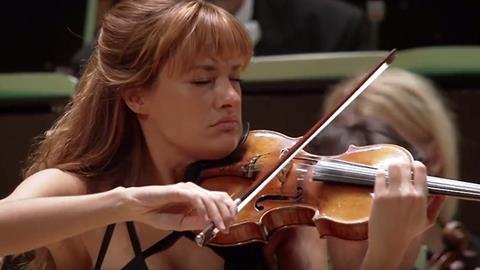
Nicola Benedetti began as a student of the Suzuki method
SUZUKI MUSICIANS
Just a few of the violinists who began as students of the Suzuki method
- Frank Almond
- Nicola Benedetti
- Martin Chalifour
- Sarah Chang
- Ray Chen
- Julia Fischer
- Hilary Hahn
- Christian Howes
- Leila Josefowicz
- Anne Akiko Meyers
- David Perry
- Arabella Steinbacher
‘We’re intrigued by what these teachers do. We’re learning more, we’re researching more, we’re having things thrown at us at workshops, which are great for learning. We’re opening up more – we’re not the cult that we used to be!’ In contrast to the ‘cult’ that may have grown up around Suzuki’s method, the man himself wanted teachers to be inventive and evolving. During his lifetime, he helped put in place a system of teacher-training, which has also shown substantial growth since his death. To be a Suzuki teacher in Europe, you must pass at least Examination Level 1 of the Suzuki teacher-training system.
Now, the Asian chapters are patterning their own teacher-training syllabus after that of the ESA. In June (2012), China opened its first official ASA Suzuki training programme, at Xiamen University in Fujian province. This was initiated by Lan Ku Chen, a Suzuki violin teacher who was trained in the US. Lan also helped establish the Suzuki-based Taiwan Talent Education Association in 2009. In the Americas, teachers can study Suzuki pedagogy at a university or at summer institutes around the US. ‘Being the huge – and enthusiastic – country it is, America quickly took to the Suzuki method,’ says Brunner. ‘But when people ask, I always say that America has both the best and the worst teachers!’
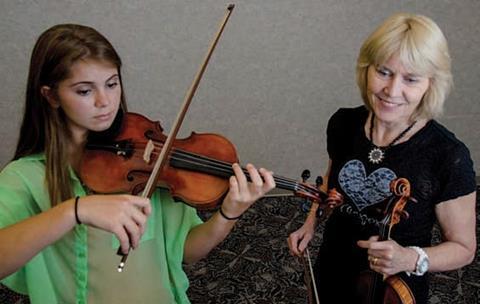
Did the Suzuki method really produce ‘the worst teachers’, once upon a time? In its earliest days, it’s true that there was a cult-like embrace of the method, which Suzuki teachers have taken pains to remedy over the years. Perhaps the worst misunderstanding from the early days of Suzuki teaching involved note-reading. When Western teachers observed Shin’ichi Suzuki teaching by rote – not using sheet music – they construed this to mean that they were not to use written music. They failed to realise that Japanese students were learning to read music – just not at their violin lessons. They learnt it as a regular subject in school.
A number of Western Suzuki teachers took this to an extreme: ‘The children weren’t allowed to look at a piece of music – it was evil to look at music!’ Solomon laughs. The music-reading criticism of Suzuki lingers, but in reality, Suzuki teachers have changed a great deal. ‘Every good Suzuki teacher I know teaches note-reading sooner than they used to,’ Lewis says. In fact, Suzuki-ites have come up with new ways of introducing pre-reading children to concepts of note-reading, in the same way pre-schoolers learn the alphabet before phonics.
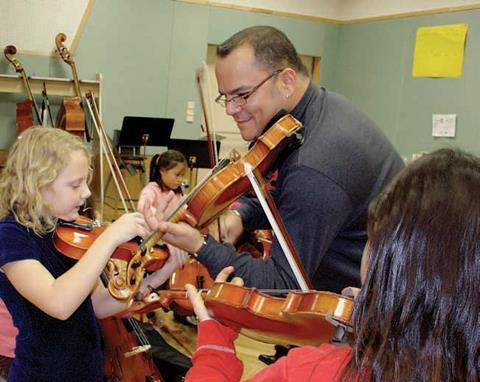
In 1992 US Suzuki piano teacher Michiko Yurko created Music Mind Games, materials aimed at very young students who couldn’t yet read words. The activities use vocabulary and games to introduce the symbolic language of pitch and rhythm. ‘We generally start the kids reading at the end of Book 1,’ Lewis explains. This is in keeping with the Suzuki idea that children learn to speak before they learn to read: one learns positioning and concepts of sound before learning its symbolic representation. ‘Now we know how important it is to read, to learn other repertoire, to do scales,’ Solomon says. ‘We must combine the real violin traditions into our Suzuki method.’ Suzuki teachers are also less inclined to look on the Suzuki books as immutable. Not only is there an ongoing, coordinated international effort to revise the books, but there is also an increased willingness to look beyond them.
California-based violinist and teacher Jesús Florido first learnt of Suzuki in the 1970s, as a boy in Venezuela’s then-new El Sistema music education programme. His teacher, Eligiusz Stoin´ski, presented him with Suzuki Book 1, saying in his Russian accent, ‘There is a Japanese man who wrote this book. You should try it.’ They went through the books, including Suzuki’s treatise on music education called Nurtured by Love. Florido and his teacher embraced Suzuki’s repertoire and philosophy as something helpful in teaching the other kids enrolled in El Sistema – Florido started teaching at age 13. But Florido’s experience with the Suzuki method in America was not so positive. He moved to the US as a young man, and took his first job teaching at a Suzuki academy. ‘I became exposed to the whole Suzuki Midwest mentality,’ he remembers, ‘which I have to say was not necessarily positive. It was very cult-like. I remember thinking, “This is not what Suzuki is about!”’ Most bothersome was an adherence to the Suzuki repertoire, as if it were holy canon, with no allowance for deviation: ‘If I were to quote examples for a different scale, for example, I would get yelled at.’
Florido clarified the matter for himself in the early 1990s, when he got to speak to Shinichi Suzuki in person at a conference in Chicago. ‘I talked to him for about 15 minutes by myself, and it was the most beautiful 15 minutes I’ve had,’ he recalls. Suzuki knew about the music education experiments in Venezuela, and he was anxious to learn more. ‘He asked me if we used the method, and I said, “Sure we do. We use it as a supplement to our teaching.” And he told me, “That’s what it’s intended to be.” So you cannot skip Kreutzer, or 200 years of violin teaching. You can’t use just one book,’ Florido concludes. ‘Suzuki told me that nothing was more important than playing the violin. He said that no matter what means you use, teach well.’
Suzuki teaching: Every child can
- 1
- 2
- 3
- 4
- 5
- 6
 Currently reading
Currently readingGlobal impact of Suzuki: The method and the movement
- 7
- 8
- 9
- 10
- 11
- 12

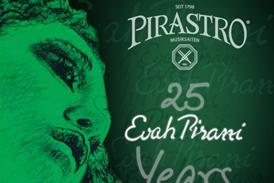

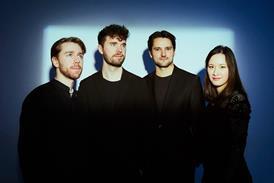









































1 Readers' comment